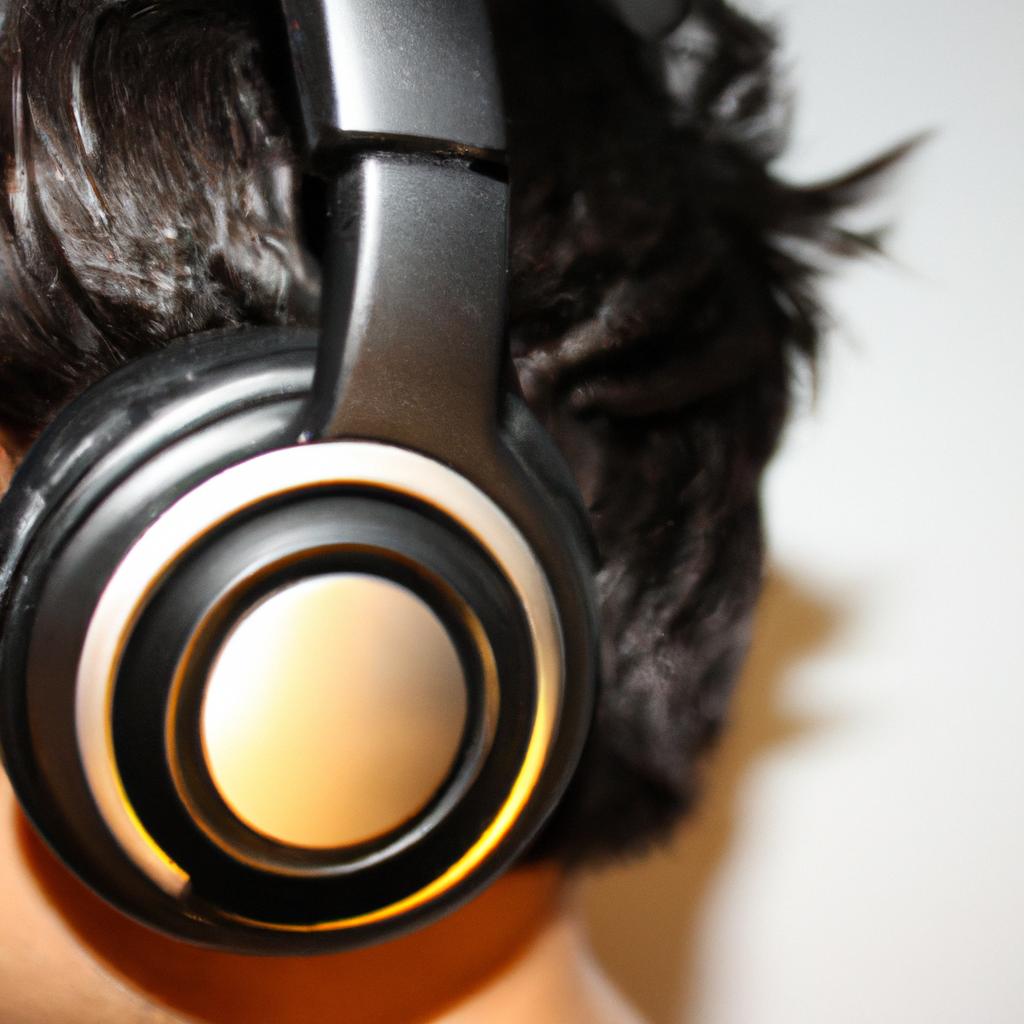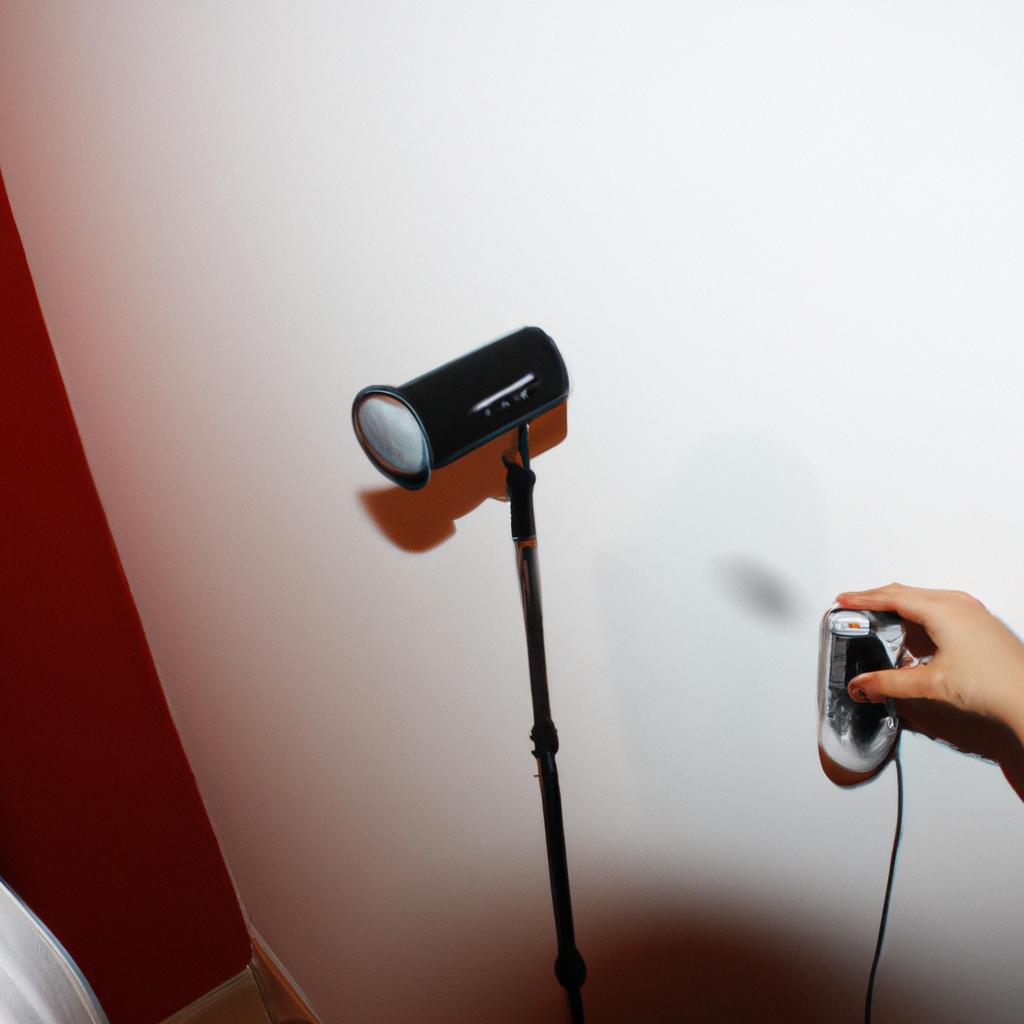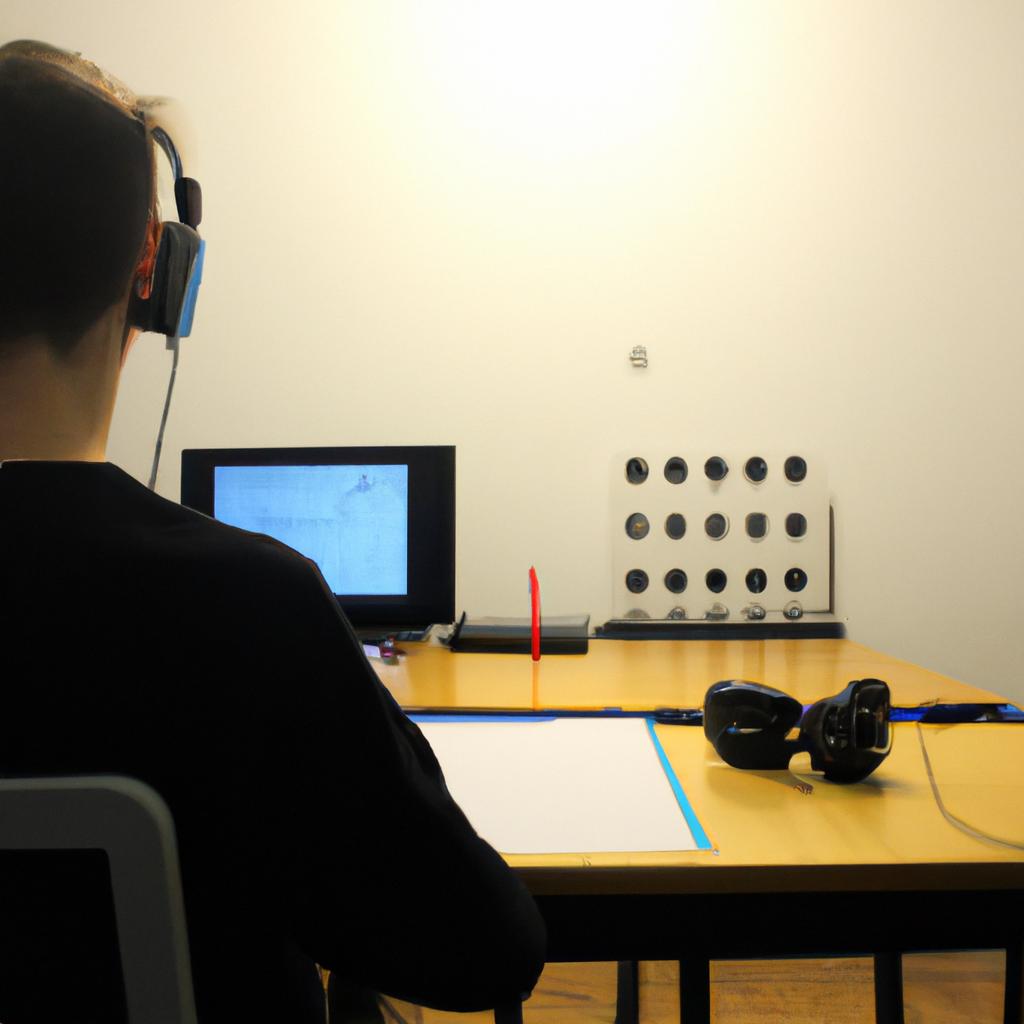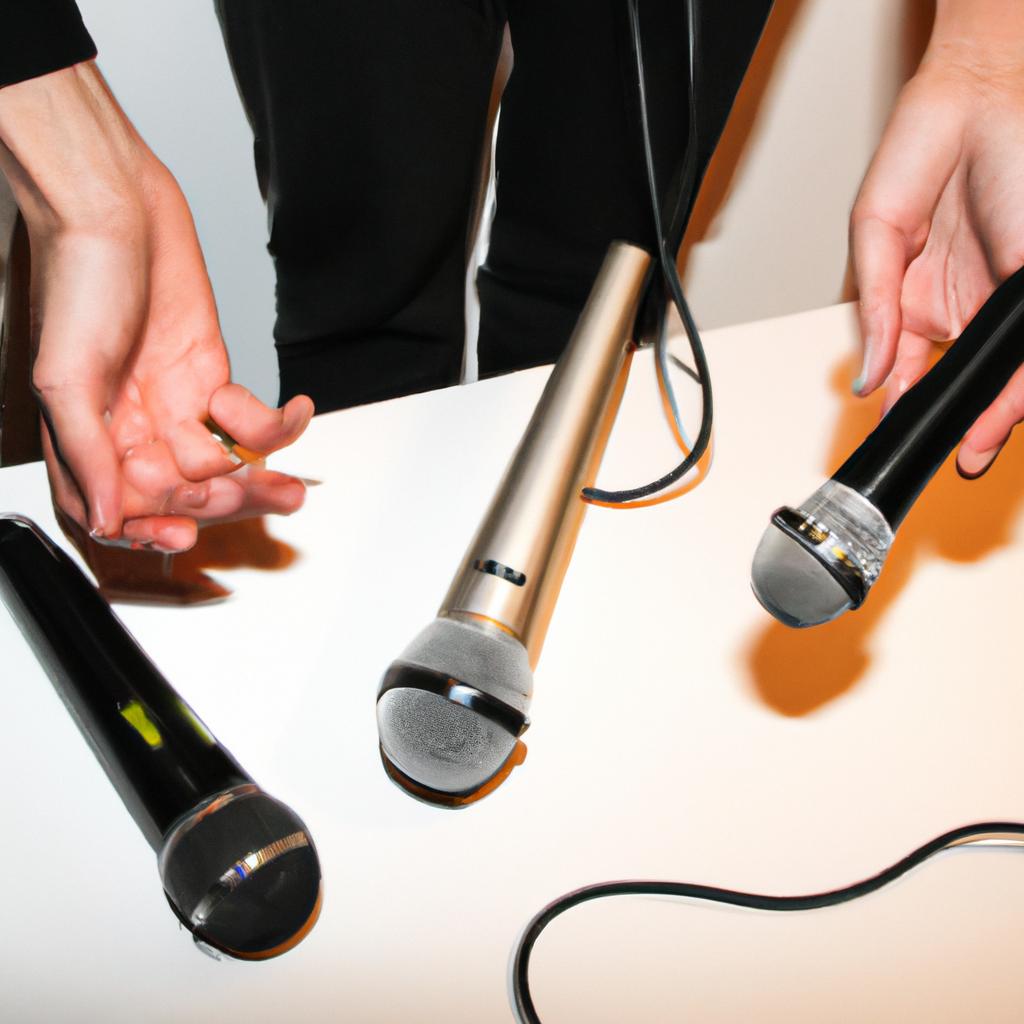Noise reduction in sound and vision acoustics plays a crucial role in enhancing the sonic experience. By minimizing unwanted noise, it allows for greater clarity and immersion in audiovisual content, creating a more enjoyable and immersive experience for audiences. For instance, consider a hypothetical scenario where a moviegoer is watching an action-packed film in a crowded cinema hall. The background noise from other viewers talking or munching on snacks can significantly detract from the overall cinematic experience. However, by employing effective noise reduction techniques, such as acoustic panels or advanced signal processing algorithms, the distracting noises can be minimized, allowing viewers to fully immerse themselves in the captivating world of the film.
In recent years, advancements in technology have revolutionized noise reduction methods across various domains of sound and vision acoustics. From home entertainment systems to concert halls and recording studios, there is an increasing demand for superior audio quality with minimal interference from ambient noise sources. This article aims to explore the principles behind noise reduction techniques and their applications in different contexts. By understanding these concepts, professionals working in fields like audio engineering, filmmaking, music production, and architectural design can effectively implement strategies that enhance the sonic experience while maintaining high-quality sound reproduction fidelity. Through further examination of case studies and real -world applications, we can gain insights into the practicality and effectiveness of various noise reduction techniques.
One such case study involves the use of active noise cancellation (ANC) in headphones. ANC technology utilizes microphones to capture ambient sounds and generates an inverse sound wave that cancels out these unwanted noises. This allows users to enjoy their music or audio content without being disturbed by external sounds like traffic or conversations. ANC has become increasingly popular in consumer headphones, providing a more immersive and isolated listening experience.
Another application of noise reduction is seen in recording studios. These spaces are designed with acoustic treatments, including soundproofing materials and diffusers, to minimize external noise interference and create an optimal recording environment. By reducing reflections and reverberations, studios can achieve cleaner recordings with improved clarity and accuracy.
In architectural design, noise reduction techniques play a crucial role in creating comfortable living and working environments. Buildings near busy streets or airports often face challenges with external noise infiltration, which can disrupt concentration and sleep patterns. To address this issue, architects employ strategies such as double-glazed windows, insulation materials, and structural modifications to reduce sound transmission from outside sources.
Furthermore, noise reduction is vital in live performance venues like concert halls. Acoustic panels and diffusers are strategically placed to absorb or scatter sound waves, optimizing the acoustics for both performers on stage and audiences alike. By minimizing echoes or unwanted reflections, concertgoers can fully appreciate the nuances of the music while maintaining a clear auditory experience.
Overall, noise reduction techniques have become integral components across different domains of sound and vision acoustics. Whether it’s enhancing personal entertainment experiences through ANC headphones or designing architectural spaces with optimized acoustics, the goal remains consistent – to minimize unwanted noise interference and provide a more immersive sonic experience for individuals in various contexts.
Understanding Noise Reduction
Imagine sitting in a crowded coffee shop, trying to have an important conversation with a colleague. The constant background noise of conversations, clattering dishes, and the hissing steam from the espresso machine can make it difficult to focus on what is being said. This scenario exemplifies how excessive noise can disrupt communication and diminish the overall experience. In various fields such as sound engineering, audiovisual production, and architectural acoustics, understanding noise reduction techniques is crucial for enhancing the sonic experience.
To delve into the realm of noise reduction, it is essential to comprehend its underlying principles. First and foremost, noise refers to any unwanted or random sound that interferes with desired sounds or signals. It often manifests as ambient noise in environments where multiple sources contribute to overall acoustic clutter. By employing effective noise reduction strategies, one aims to minimize these disruptive elements and improve the clarity of desired sounds.
A key aspect of comprehending noise reduction lies in acknowledging different types of noises and their characteristics. Some common examples include:
- Background noise: Consistent low-level sounds that persist throughout an environment.
- Impulsive noise: Sudden bursts of loud sounds that may startle or distract individuals.
- Reverberation: Prolonged echoes caused by sound reflections within enclosed spaces.
- White noise: A continuous mixture of all audible frequencies that can help mask other distracting noises.
Noise reduction employs a range of methods and technologies to combat these disruptive elements effectively. These approaches encompass both passive techniques (e.g., insulation materials) and active mechanisms (e.g., digital signal processing algorithms). Additionally, advancements in technology have led to innovative solutions such as smart devices equipped with adaptive filtering capabilities aimed at reducing specific types of noises based on real-time analysis.
By understanding the fundamentals of noise reduction and exploring diverse strategies tailored for different contexts, we pave the way towards creating more immersive auditory experiences. In the subsequent section, we will explore the importance of noise reduction in sound and vision, highlighting its impact on various aspects of our lives, from entertainment to workplace productivity.
Importance of Noise Reduction in Sound and Vision
Imagine sitting in a crowded coffee shop, attempting to have a conversation with a friend. As the sounds of baristas grinding coffee beans, customers chatting, and music playing fill the air, it becomes increasingly challenging to focus on your discussion. This scenario highlights the importance of noise reduction in sound and vision acoustics. By minimizing unwanted background noise, we can enhance our sonic experience and improve communication across various domains.
To fully grasp the significance of noise reduction techniques, let us delve into the underlying science. Sound waves are characterized by their amplitude (loudness) and frequency (pitch). When multiple sound sources coexist within an environment, they interact and create a cacophony that hampers clarity. However, through advancements in technology and research, several methods have been developed to mitigate these challenges effectively.
One such technique is active noise cancellation (ANC), which employs microphones strategically placed near the listener’s ears to detect incoming ambient sounds. These detected signals are then inverted and played back through headphones or speakers instantaneously, resulting in destructive interference that cancels out external noises. ANC has proven particularly useful in environments like airplanes or construction sites where constant exposure to high decibel levels can lead to hearing damage over time.
Nowadays, engineers also employ passive noise control measures alongside ANC for optimal results. Passive techniques involve physical modifications made to spaces or objects to minimize sound transmission. Examples include installing acoustic panels on walls and ceilings to absorb excess reverberation or using sound barriers along highways to reduce road traffic noise pollution. Combining both active and passive techniques allows for comprehensive noise reduction tailored specifically to each unique setting.
Let us now explore some emotional responses associated with effective implementation of noise reduction:
- Relief: A sense of relief washes over individuals as they step into a quiet space after being bombarded by incessant environmental noises.
- Focus: With reduced distractions from surrounding commotion, people find it easier to concentrate on their tasks, leading to increased productivity.
- Relaxation: Noise reduction techniques create tranquil environments that promote relaxation and stress relief, offering a retreat from the hustle and bustle of daily life.
- Improved well-being: By minimizing exposure to excessive noise levels, individuals can protect their hearing health and prevent potential long-term damage.
To further illustrate the emotional impact of noise reduction, consider the following table:
| Emotional Response | Scenario |
|---|---|
| Relief | A student studying in a quiet library |
| Focus | An office worker concentrating on tasks |
| Relaxation | A spa with soothing background music |
| Improved well-being | A bedroom shielded from street noise |
As we delve into the subsequent section about “Techniques for Noise Reduction in Sound,” we will explore various methods employed by professionals across different industries. These techniques aim to provide practical solutions tailored to specific soundscapes while ensuring maximum comfort and enjoyment for users.
Techniques for Noise Reduction in Sound
In the previous section, we discussed the importance of noise reduction in sound and vision. Now, let us delve deeper into the various techniques used to reduce noise specifically in the realm of sound.
To illustrate the effectiveness of these techniques, imagine a scenario where you are attending a live concert. The performer’s voice is captivating, but unfortunately, it gets drowned out by the surrounding audience chatter and background noises. This situation highlights the need for effective noise reduction techniques to enhance our sonic experience.
There are several approaches that can be employed to minimize unwanted noise and improve audio quality:
- Acoustic Insulation: By utilizing materials with high sound absorption capabilities, such as foam panels or curtains made from heavy fabrics, ambient noise can be reduced significantly.
- Active Noise Cancellation (ANC): ANC technology uses microphones to capture incoming sounds and then generates inverse sound waves that effectively cancel out those frequencies, resulting in a quieter environment.
- Equalization (EQ): Through EQ adjustments, specific frequency ranges can be attenuated or enhanced to optimize audio clarity and eliminate undesirable noise components.
- Signal Processing Algorithms: Advanced algorithms analyze audio signals in real-time, identifying and suppressing unwanted background noises while preserving desired sound elements.
Table: Comparative Analysis of Noise Reduction Techniques
| Technique | Pros | Cons |
|---|---|---|
| Acoustic Insulation | Effective at reducing | Limited impact on low |
| external noises | frequency sounds | |
| Active Noise | Highly efficient | Requires power source |
| Cancellation (ANC) | Creates an immersive | May introduce artifacts |
| listening experience | ||
| Equalization (EQ) | Precise control over | Can distort overall |
| frequency response | tonal balance | |
| Signal Processing | Real-time adaptation | Computational complexity |
| Algorithms | to changing noise |
By employing these techniques, we can significantly enhance the sonic experience in various settings, ranging from concert halls and recording studios to everyday environments like offices or homes. In the subsequent section, we will explore similar techniques specifically tailored for noise reduction in vision.
Having discussed noise reduction techniques in sound, let us now shift our focus towards minimizing unwanted visual distractions through effective methods in “Techniques for Noise Reduction in Vision.”
Techniques for Noise Reduction in Vision
By employing these techniques, visual clarity and overall user experience can be improved significantly.
Techniques for Noise Reduction in Vision:
One example of a technique used for noise reduction in vision is image denoising algorithms. These algorithms aim to remove unwanted noise from digital images while preserving important visual details. For instance, let’s consider a scenario where an outdoor surveillance camera captures footage of a busy street during nighttime. The captured video may contain various types of noise, such as random pixel fluctuations or motion blur caused by low light conditions. By applying advanced denoising algorithms, the resultant video can exhibit enhanced clarity with reduced noise artifacts, allowing users to extract valuable information more effectively.
To further understand the breadth of techniques available for noise reduction in vision, let us explore some key approaches commonly utilized:
- Spatial Filtering Techniques:
- Median filtering
- Gaussian smoothing
- Frequency Domain Techniques:
- Fourier Transform-based filters
- Wavelet-based filters
These techniques play a vital role in reducing different types of noise present in visual data by manipulating their spatial or frequency characteristics accordingly. Implementing them appropriately can result in visually pleasing outputs by minimizing disturbances caused by unwanted noise sources.
Incorporating these strategies into various applications involving visual content holds great potential benefits:
| Improved Image Quality | Enhanced User Experience | Increased Efficiency |
|---|---|---|
| Reduced Eye Strain | Sharper Visual Details | Faster Decision Making |
| Enhanced Clarity | Immersive Viewing | Higher Accuracy |
By adopting effective noise-reduction measures in vision-related fields like photography, videography, medical imaging, and computer graphics, professionals can enhance their ability to interpret and analyze visual information accurately and efficiently.
Moving forward, let us now delve into the benefits that noise reduction in both sound and vision can bring to various domains and applications.
Benefits of Noise Reduction in Sound and Vision
Enhancing the Sonic Experience: Benefits of Noise Reduction in Sound and Vision
Building upon the previous section on techniques for noise reduction in vision, this section will explore the benefits of implementing such measures in sound and vision systems. To illustrate these advantages, let us consider a hypothetical scenario where a movie theater upgrades its audiovisual technology to incorporate advanced noise reduction techniques.
Firstly, by reducing background noise in movie theaters, viewers can experience a more immersive cinematic experience. Imagine sitting in a crowded theater with people talking, popcorn crunching, and other distractions. With effective noise reduction methods, these extraneous sounds would be significantly minimized or eliminated altogether. This allows audiences to focus solely on the film’s soundtrack and visuals, enhancing their overall enjoyment and engagement with the content.
Additionally, noise reduction technologies contribute to improved speech intelligibility. In our example at the upgraded movie theater, dialogue becomes clearer as ambient noises are suppressed. This benefit extends beyond cinemas to various settings like conference rooms or lecture halls, where clear communication is crucial. By ensuring that voices remain distinct and easily comprehensible amidst surrounding noise levels, individuals can effectively convey information without confusion or strain.
- Enhances immersion: Eliminating distracting background noises creates a more captivating audiovisual experience.
- Improves comprehension: Clearer sound reproduction enables better understanding of dialogue and essential auditory cues.
- Reduces fatigue: Minimizing excessive environmental noise reduces listener fatigue during extended periods of exposure.
- Heightens emotional impact: Removing unwanted distractions allows viewers to fully engage with emotionally charged moments within films or presentations.
Moreover, we can visualize some key benefits through this three-column table:
| Benefit | Description | Emotional Impact |
|---|---|---|
| Enhanced Immersion | Eliminates distracting sounds for heightened engagement | Captivating |
| Improved Comprehension | Clear dialogue and auditory cues for better understanding | Enhanced understanding |
| Reduced Fatigue | Minimized environmental noise for decreased listener fatigue | Relieved |
| Heightened Emotional Impact | Uninterrupted focus on emotionally charged moments | Deeply moved |
In conclusion, the implementation of noise reduction techniques in sound and vision systems offers numerous advantages. From enhanced immersion to improved comprehension, these technologies provide a more enjoyable and engaging experience for audiences across various settings. The benefits of noise reduction extend beyond mere technical enhancements; they evoke emotional responses that contribute to an overall positive user experience.
Looking ahead, it is evident that the future of noise reduction technology holds great potential. By continuously refining existing methods and exploring new approaches, we can expect even greater advancements in creating immersive soundscapes and visually captivating environments. In the subsequent section about the “Future of Noise Reduction Technology,” we will delve into some exciting possibilities awaiting us in this field.
Future of Noise Reduction Technology
Section H2: Future of Noise Reduction Technology
Transitioning from the benefits of noise reduction in sound and vision, it is evident that advancements in technology continue to shape the future of this field. As we delve into the possibilities that lie ahead, let us consider a hypothetical scenario where an individual named Alex finds solace within their home thanks to cutting-edge noise reduction technology.
Imagine Alex living in a bustling city with constant traffic noise infiltrating every corner of their apartment. Seeking respite from this daily auditory assault, Alex installs a state-of-the-art noise reduction system. This technology employs advanced algorithms and acoustic materials to actively cancel out incoming sounds, creating a serene environment for relaxation and focus.
Looking forward, there are several exciting developments on the horizon that promise even greater improvements in noise reduction technology:
- Miniaturization: With ongoing research and development efforts, noise reduction systems will become increasingly compact and unobtrusive, seamlessly integrating into our everyday lives.
- Wireless Connectivity: The ability to connect wirelessly to various devices opens up new opportunities for personalized audio experiences. Users can enjoy enhanced sound quality while engaging with their favorite music or immersive virtual reality applications.
- AI Integration: Artificial intelligence (AI) plays a crucial role in shaping the future of noise reduction technology. By continuously learning from user preferences and environmental factors, AI algorithms can adaptively optimize noise cancellation settings for an unparalleled listening experience.
- Environmental Awareness: Future systems will incorporate sensors capable of detecting ambient noises more accurately. This heightened awareness enables intelligent adjustment of noise reduction levels based on specific situations such as noisy construction sites or busy urban areas.
To emphasize the potential impact these advancements may have on individuals like Alex who seek tranquility amidst chaos, consider the following table:
| Situation | Before | After |
|---|---|---|
| Commuting | Unbearable subway noise during rush hour | Peaceful and relaxing journey |
| Home Office | Distractions from neighbors and street noise | Focus and productivity boosted |
| Concerts | Overwhelming crowd noise overpowering the music | Immersive audio experience with crystal-clear sound |
| Bedroom | Sleep disrupted by loud sounds throughout the night | Deep, uninterrupted sleep for improved well-being |
In this hypothetical scenario, Alex’s life is transformed through the utilization of cutting-edge noise reduction technology. As advancements continue to revolutionize the field, we can anticipate a future where noise pollution becomes a thing of the past.
Through miniaturization, wireless connectivity, AI integration, and environmental awareness, these developments hold great promise in enhancing our sonic experiences. By embracing such innovations, individuals like Alex can reclaim their auditory environments, finding solace amidst the chaos of modern life.











